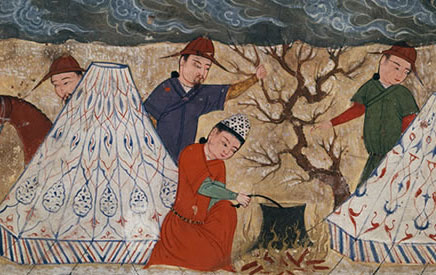
Khubilai Khan and Chabi on a Cookout (detail), Bibliothèque nationale de France, Paris
During one of his periodic visits to his native land, the Tibetan monk ['Phags-pa] was greatly impressed by a newly constructed Buddhist temple designed by the Nepalese craftsman Aniko (1244-1306).
Despite Aniko's protestations and his desire to return to Nepal, the 'Phags-pa lama took the Nepalese artisan with him to China in 1265. He soon arranged an imperial audience for Aniko, and the Great Khan and the Nepalese craftsman formed favorable impressions of each other.
Khubilai first tested Aniko's abilities by ordering him to repair a damaged copper image of a man, which was used for acupuncture. The test turned out to be a great success, as Aniko performed a remarkable restoration.
Overwhelmed by Aniko's talents, Khubilai assigned him a number of construction projects. Aniko designed and built a Buddhist temple, the Dahu Guoren Wangsu, and a pavilion in a park in Daidu [the Mongol capital in China], an ancestral temple in Zhozhou, and a temple in Shangdu [also called Xanadu] among others. He also fashioned some beautiful gold and jade jewelry.
Clearly delighted with Aniko, Khubilai offered lavish rewards to the young Nepalese. In 1273, he was named the head of the Directorate General for the Management of Artisans, making him the supervisor of all craftsmen in China. Later he was granted an elegant home, together with land, in the Xienili section of Ta-tu.
Khubilai and his family thus recognized a great craftsman and welcomed and rewarded him for his efforts. The non-Chinese craftsmen were given the same opportunities for success and patronage as Chinese.
— Text excerpted from Khubilai Khan: His Life and Times, by Morris Rossabi (Berkeley: University of California Press, 1988), p. 171